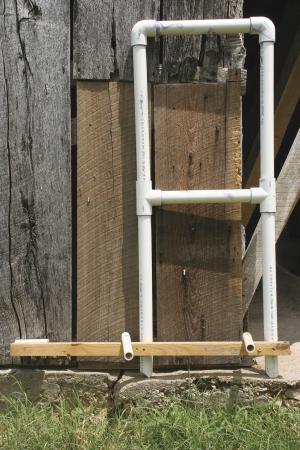PVC Punch-Plants Into Plastic Mulch
 ✖  |
Planting strawberry plugs into plastic-covered beds goes fast for Emily Oakley and Mike Appel, thanks to a device they designed to put perfectly spaced holes in the plastic and mark where the next hole goes. The device lets them plant strawberries quickly and accurately.
“We plant 2,000 plugs per year on six 200-ft. beds,” says Oakley. “We plant plugs or well-rooted tips instead of fresh dug crowns. Crowns need more babying than plugs and generally aren’t available when we want to plant.”
Oakley and Apple, who raise and market fruits and vegetables in Oklahoma, plant their strawberries in October. This gives the plants two months to get established before freezing temperatures arrive. Their planting regimen, which includes fall planting and tilling up beds at the end of the fruiting season, was featured recently in Growing for Market, a trade magazine for local food producers (www.growingformarket.com).
“We plant two rows of strawberries 16 in. apart with plants 16 in. apart within the rows,” explains Oakley. “It’s important to plant at the correct depth so the roots are well-buried, but the crown remains above the soil.”
Their planting device is made from pieces of 1 1/4-in. dia. pvc pipe connected in a U shape. It’s about 4 ft. tall with a cross pipe at the mid point. The open end of the U is attached to a 1-in. thick wooden slat with the pipe ends extending about 4 in. past the slat. The ends are beveled, creating a sharp edge to punch through the plastic.
The wooden crossbar maintains a common depth for holes. It also extends another 16 in. beyond one pipe end. As the U ends are pressed down into the bed, a long screw drilled through the end of the slat marks where the next hole in line for that row will go. At the same time, the leg centered on the slat is creating a new hole that was previously marked, and the other end is slipping into the last hole made.
Once the first two holes have been made, the process ensures that holes down the row stay in line. While one of the pair is making holes, the other is following behind, slipping plugs into the holes in the plastic and firming up soil around them.
While other growers get two or more growing seasons from a matted bed, Oakley and Appel get only one. Higher annual plant purchases, the cost of the black plastic and annual transplant labor are offset by avoiding irrigation and weeding during the worst of the summer heat.
Contact: FARM SHOW Followup, Emily Oakley and Mike Appel, 1367 Highway 82A, Oaks, Okla. 74359 (ph 918 868-5450; farmers@threespringsfarm.com; www.threespringsfarm.com).

Click here to download page story appeared in.
Click here to read entire issue
PVC Punch-Plants Into Plastic Mulch PLANTERS Planting strawberry plugs into plastic-covered beds goes fast for Emily Oakley and Mike Appel thanks to a device they designed to put perfectly spaced holes in the plastic and mark where the next hole goes The device lets them plant strawberries quickly and accurately “We plant 2 000 plugs per year on six 200-ft beds ” says Oakley “We plant plugs or well-rooted tips instead of fresh dug crowns Crowns need more babying than plugs and generally aren’t available when we want to plant ” Oakley and Apple who raise and market fruits and vegetables in Oklahoma plant their strawberries in October This gives the plants two months to get established before freezing temperatures arrive Their planting regimen which includes fall planting and tilling up beds at the end of the fruiting season was featured recently in Growing for Market a trade magazine for local food producers www growingformarket com “We plant two rows of strawberries 16 in apart with plants 16 in apart within the rows ” explains Oakley “It’s important to plant at the correct depth so the roots are well-buried but the crown remains above the soil ” Their planting device is made from pieces of 1 1/4-in dia pvc pipe connected in a U shape It’s about 4 ft tall with a cross pipe at the mid point The open end of the U is attached to a 1-in thick wooden slat with the pipe ends extending about 4 in past the slat The ends are beveled creating a sharp edge to punch through the plastic The wooden crossbar maintains a common depth for holes It also extends another 16 in beyond one pipe end As the U ends are pressed down into the bed a long screw drilled through the end of the slat marks where the next hole in line for that row will go At the same time the leg centered on the slat is creating a new hole that was previously marked and the other end is slipping into the last hole made Once the first two holes have been made the process ensures that holes down the row stay in line While one of the pair is making holes the other is following behind slipping plugs into the holes in the plastic and firming up soil around them While other growers get two or more growing seasons from a matted bed Oakley and Appel get only one Higher annual plant purchases the cost of the black plastic and annual transplant labor are offset by avoiding irrigation and weeding during the worst of the summer heat Contact: FARM SHOW Followup Emily Oakley and Mike Appel 1367 Highway 82A Oaks Okla 74359 ph 918 868-5450; farmers@threespringsfarm com; www threespringsfarm com
To read the rest of this story, download this issue below or click
here to register with your account number.







